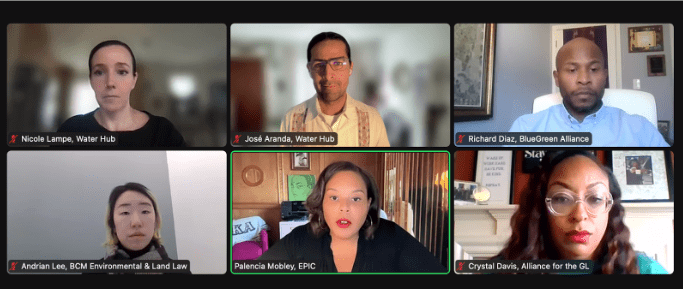The Great Lakes is often described as a climate refuge because of its ample fresh water, but its cities have some of the country’s oldest public plumbing. From lead pipes supplying water to homes and schools to stormwater systems that spill sewage during heavy rains, the region’s aging water infrastructure is in desperate need of an update, especially communities that have historically been disinvested. Fortunately, the Bipartisan Infrastructure Law is sending billions of dollars to Great Lakes states to fund clean water and climate readiness, with a directive to invest 40% in areas that are under-resourced and overburdened by pollution.
The Water Hub invited four local experts for the first of two regional media briefings to update us on where those funds are flowing, and what’s needed to help Great Lakes communities tackle long-standing flooding and pollution problems while creating local jobs. Below, we share highlights from our conversation. You can watch the full video below, and read the transcript here.
Andrian Lee, BCM Environmental & Land Law:
“The Bipartisan Infrastructure Law authorized the EPA to administer a historic $30 billion for drinking water infrastructure projects through the drinking water SRF over the following 5 years. And to put that into context: from 2017 to 2021, Congress authorized about $1 billion dollars each year for drinking water infrastructure projects. So $30 billion is just a huge amount.”
“Just in the Great Lakes alone, we have a huge funding gap of over $100 billion to improve our water infrastructure. We need to be creative in coming up with solutions and making sure that funding gets to the communities that need it.”
“The way that states define disadvantaged communities is essential to how this money [from the Bipartisan Infrastructure Law] essentially is going to get distributed to communities to replace their lead service lines, which disproportionately affects communities of color.”
Richard Diaz, BlueGreen Alliance:
“The proposed [Lead and Copper] Rule is a ray of hope. It improves critical aspects of the existing Lead and Copper Rule, including requiring most public lead service lines to be replaced within 10 years… But the final rule can go even further by including additional equity considerations such as full lead service line replacement located on the private side of properties, and addressing the proper disposal of lead lines.”
“An analysis by the BlueGreen Alliance found that $15 billion allocated for repairing and replacing lead lines would create over 200,000 jobs across 10 years. And within our coalition, these are not just numbers. These are real jobs for steel workers to manufacture pipes and for plumbers and pipefitters to install those pipes and replace lines.”
“While 2021 was a year that the nation made its greatest investment in water infrastructure through the Bipartisan Infrastructure Law, 2023 was the year that utilities have requested the most amount of money they’ve ever requested from state agencies to replace lead pipes.”
Palencia Mobley, Environmental Policy Innovation Center:
“Right now, you’re seeing that who typically gets the [State Revolving Funds] money, they’re getting the money. [We’re] trying to get the folks who’ve never applied, who don’t even understand what it is, but they got projects and help navigate that process for them.”
“We all know climate change is driving a lot of this… I was the person who could say, Hey, we shouldn’t build another thing that’s impervious. How many more buildings do we need? How many more houses do we need? Because the more we begin to encroach upon natural systems that already exist, we continue to erode at the foundational systems that really will support life and activity.”
“But there is one big thing that we never talk about with utility and public sector jobs: they don’t pay. So, even though the barrier oftentimes to entry is small. You just need to have a GED or diploma, and a drivers license a lot of times because there’ll be vehicles you need to drive… but the pay is a barrier to entry.”
Crystal Davis, Alliance for the Great Lakes:
“We are super grateful for the Bipartisan Infrastructure Law and the significant historic funding that’s going to this issue. But it’s really important to remember that this is a down payment on a really big deal… We talk a lot about water infrastructure because we’re at a point where our water treatment systems, our lead service lines, our pipelines are way beyond their useful life span.”
“We know that the Federal government share of capital spending and the water sector fell from 69% in 1977 to 9% of the total capital spending in 2017. And so you know, we need to leverage the federal investment that we have right now, with state and local investment. All of that to say that because there’s going to be a gap, somebody has to fill it, and we know that we cannot afford for that to fall on the backs of ratepayers that are already struggling to make ends meet.”
“Authentic community engagement starts at the ideation stage. It’s not gonna be enough for us to try to bring community to the table at the end of these conversations and ask, was that good? It’s gonna be imperative that we start to have conversations with the people that have been under-resourced, under-valued, under-invested right now.”
What’s next?
Follow us on LinkedIn and Twitter/X to stay in the loop about future briefings, trainings, resources, and more.
